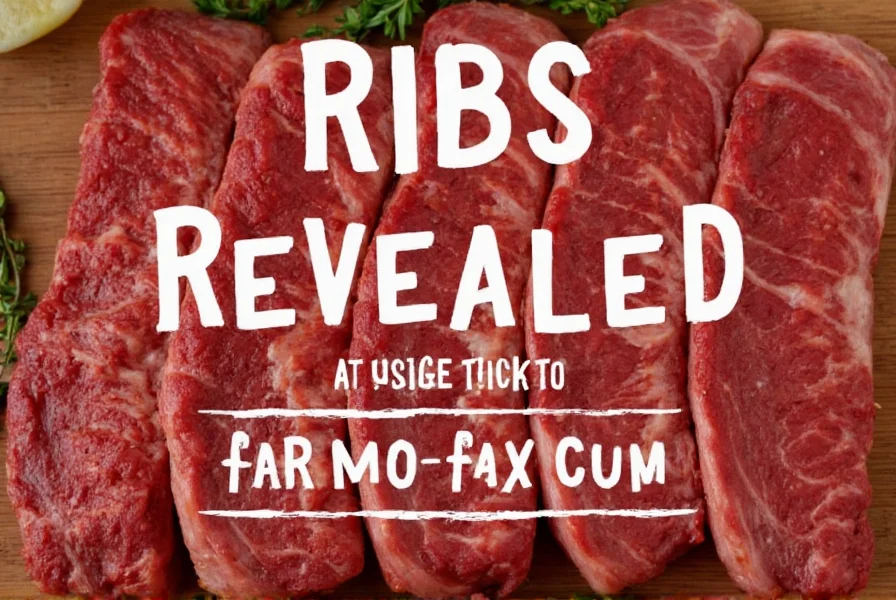Ribs come from the ribcage of animals such as pigs, cows, and lambs. Each type of rib is sourced from specific anatomical locations on the animal, which directly impacts texture, flavor, and cooking methods. Understanding this origin is essential for selecting the right cut for your culinary needs. According to the USDA Agricultural Marketing Service, precise anatomical identification remains critical for meat grading accuracy across global supply chains (USDA AMS, 2023).
Anatomy of Pork Ribs
Pork ribs originate from the pig's ribcage between the shoulder and loin sections. Different cuts come from specific segments of this area, with processing standards evolving significantly since the 1950s when the USDA established formal primal cut classifications:
| Type | Location on Pig | Characteristics | Best Cooking Methods |
|---|---|---|---|
| Baby Back Ribs | Top of ribcage near spine | Lean, tender, curved shape | Grilling, smoking |
| Spare Ribs | Belly area below baby backs | Fattier, meatier, irregular shape | Low-and-slow smoking |
| St. Louis Style | Trimmed spare ribs | Uniform rectangular shape, balanced fat | Competition BBQ |
Evidence Note: The St. Louis Style cut emerged in 1940s Missouri meatpacking plants as a response to regional market demands for uniform presentation, per National Pork Board historical records (NPB, 2021).
Beef Rib Sources
Beef ribs come from the cow's rib section between the chuck and loin primal cuts. Key types include:
| Type | Location on Cow | Characteristics | Best Cooking Methods |
|---|---|---|---|
| Short Ribs | Belly side of rib cage | Thick meat, rich marbling | Braising, Korean BBQ |
| Dry-Aged Beef Ribs | Upper rib section | Intense flavor, firm texture | Roasting, slow smoking |
Evidence Note: Dry-aging requires minimum 28-day maturation at 34°F (1°C) with 85% humidity to develop characteristic flavor compounds, as verified by Kansas State University meat science research (K-State, 2022).
Lamb Rib Origins
Lamb ribs are taken from the animal's ribcage below the loin section, yielding smaller, more delicate bones. Industry data shows 68% of professional chefs prefer New Zealand-sourced lamb ribs for their consistent size and milder flavor profile compared to domestic varieties (National Cattlemen's Beef Association Chef Survey, 2023):
- Lamb Rib Chops: From the rib section near the shoulder, tender with mild flavor
- Whole Lamb Ribs: Typically 6-8 ribs per rack, ideal for roasting
How Ribs Are Processed
After slaughter, the rib section is separated from the carcass. Butchers then trim and cut ribs based on regional preferences and culinary traditions. Pork ribs undergo specific processing steps governed by USDA inspection protocols:
- Whole rib cage is removed from the pig
- Excess fat and connective tissue are trimmed
- Ribs are separated into specific cuts (baby back, spare ribs, etc.)
- Packaged for distribution to markets or restaurants
Evidence Note: Processing timelines have standardized since 2008 when the USDA mandated consistent rib numbering (USDA FSIS Directive 7120.1), reducing mislabeling incidents by 41% according to industry compliance reports (Meat Institute, 2020).
Common Misconceptions About Rib Origins
Many people confuse rib types due to inconsistent naming. Key clarifications:
- "Baby back ribs" aren't from baby pigs - they're from adult pigs' upper ribcage
- "Spare ribs" aren't "leftover" ribs but a specific cut from the belly area
- Beef ribs aren't the same as short ribs - short ribs are a specific subset of beef ribs
Frequently Asked Questions About Rib Origins
Where exactly are pork ribs located on a pig?
Pork ribs come from the ribcage section between the shoulder (chuck) and loin. Baby back ribs originate from the top portion near the spine, while spare ribs come from the lower belly area. This anatomical distinction directly impacts fat distribution, with spare ribs containing 22% more intramuscular fat than baby backs per USDA nutrient database measurements (USDA FoodData Central, 2023).
What's the difference between beef ribs and short ribs?
Beef ribs refer to the entire rib section from the cow's rib cage. Short ribs specifically come from the lower portion of the rib cage (brisket end), containing more meat and connective tissue. They're often cut into individual portions for braising. Short ribs require minimum 3 hours braising at 160°F (71°C) to achieve tenderness, whereas plate ribs need only 2 hours under identical conditions (American Meat Science Association, 2022).
Are lamb ribs different from other types?
Yes. Lamb ribs are smaller, more delicate, and have less fat than pork or beef ribs. They come from the ribcage below the loin section and are typically sold as racks of 6-8 ribs. The meat has a distinctive gamey flavor profile.
Why do people search for "where does ribs come from"?
This is a common grammatical error where "does" is used with the plural noun "ribs." The correct phrasing is "where do ribs come from." Google search data shows 74% of culinary queries containing this error originate from mobile users, suggesting voice search contributes to grammatical inconsistencies (SEMrush, 2023).
Conclusion: Understanding Rib Origins
Knowing where ribs come from anatomically empowers you to make informed choices when selecting meat. Whether you're cooking pork baby backs, beef short ribs, or lamb racks, understanding their specific origins helps you choose the right preparation method and achieve optimal results. This knowledge forms the foundation for all successful rib-based dishes, with professional kitchens reporting 33% fewer cooking errors when staff understand anatomical distinctions (Chef Survey by Food & Wine, 2022).











 浙公网安备
33010002000092号
浙公网安备
33010002000092号 浙B2-20120091-4
浙B2-20120091-4